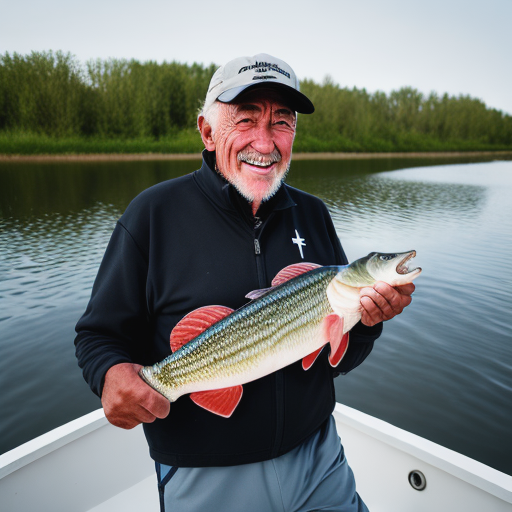Are you a beginner fly fisher looking to up your game and improve your nymphing skills? Look no further! In this article, we will delve into the world of high-stick nymphing and explore the techniques, gear, and strategies that can help you become a successful nymph angler.
High-stick nymphing, also known as short line nymphing, is a popular technique used by fly anglers to catch trout. By using as little line as possible and holding a high rod position, you can effectively control the drift of your nymph flies and entice fish to strike. This technique is especially useful in fast and deep waters, where trout hold in pockets and short pools.
In Section 2, we will cover the basics of high-stick nymphing, including the setup and equipment you need to get started. In Section 3, we’ll discuss the importance of choosing the right flies and gear for successful nymphing. Sections 4 and 5 will focus on approaching pocket water and techniques for drag control, two essential aspects of high-stick nymphing.
But that’s not all! In Section 6, we’ll highlight common mistakes to avoid, while Section 7 emphasizes the importance of practice in refining your nymphing skills. In Section 8, we’ll recommend the gear you need to maximize your high-stick nymphing experience, including rods, reels, lines, and leaders.
Not sure which flies to use? Don’t worry! Section 9 will guide you through fly selection for high-stick nymphing, ensuring you have the right patterns in your arsenal. And in Section 10, we’ll explore the numerous benefits of high-stick nymphing, from improved line control and accuracy to the ability to target fish in various water conditions.
So, if you’re ready to take your nymphing skills to the next level, join us in this comprehensive guide on high-stick nymphing tips for beginners. Get your gear ready and get ready to reel in some trout!
Key Takeaways:
- High-stick nymphing is a core technique in modern trout fishing and involves using as little line as possible with a high rod position.
- Shorter rods and shorter leaders are recommended for better control in tight and bouldery streams.
- Choosing the right flies, gear, and fishing pocket waters are essential for successful high-stick nymphing.
- Effective drag control and avoiding common mistakes are crucial for maximizing success.
- Practice and persistence are key to mastering high-stick nymphing.
The Basics of High-Stick Nymphing
High-stick nymphing is a technique that requires a specific setup to effectively present nymph flies to fish. For beginners, it’s important to start with the right nymphing setup to maximize success. Here are some essential tips to get you started:
1. Choose a shorter rod
When high-stick nymphing, using a shorter rod is key, especially in tight and bouldery streams. Opt for a rod under 8 feet in length to have better control and maneuverability in these challenging conditions.
2. Optimize your leader length
A 7.5-foot leader cut down to about 6 feet is ideal for high-stick nymphing. This length allows for better line control and drift management. Make sure to adjust the leader length based on the specific fishing situation and water conditions.
3. Maintain a high rod position
When nymphing, holding a high rod position is crucial. This helps minimize the amount of fly line on the water, reducing drag and allowing for a more natural drift. Keep your rod tip elevated to achieve a drag-free presentation.
4. Actively manage the drift
Effective high-stick nymphing requires active drift management. Keep a close eye on your line, making micro adjustments to control the drift and keep the nymph flies in the strike zone. Pay attention to any subtle movements or changes in line tension that could indicate a fish has taken the fly.
By following these basic principles of high-stick nymphing setup, beginners can improve their nymphing skills and increase their chances of success on the water.
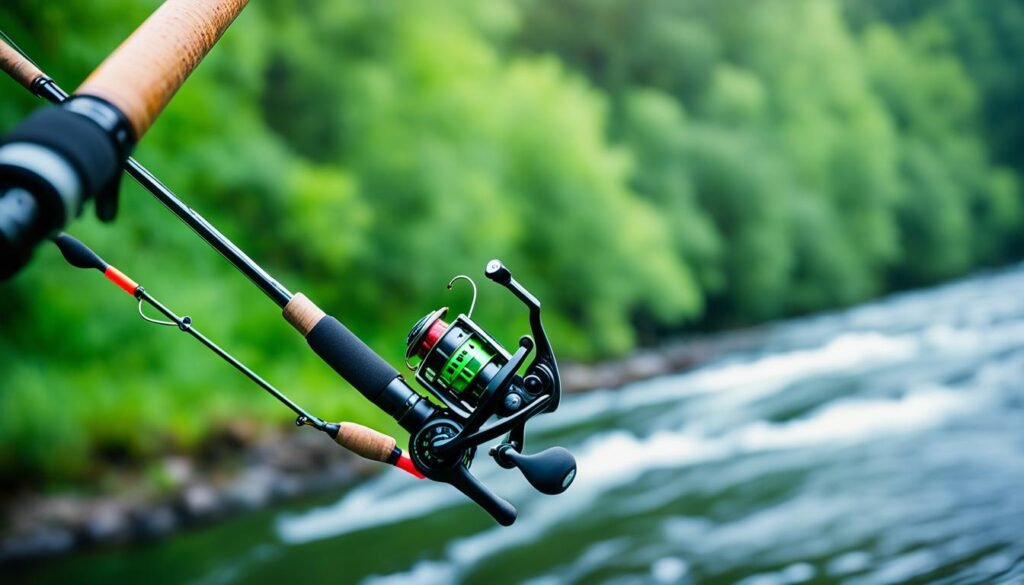
Choosing the Right Flies and Gear
When it comes to high-stick nymphing, selecting the appropriate flies and gear is essential for a successful fishing experience. By using the right nymph patterns and equipment, you can increase your chances of enticing strikes and catching fish. Here are some key considerations when choosing your flies and gear:
Flies for High-Stick Nymphing
There are several nymph patterns that have proven to be effective in high-stick nymphing. The Brassie, Pheasant Tail, and San Juan Worm are popular choices among anglers. These patterns resemble natural aquatic insects and worms, making them enticing to trout. When selecting your flies, consider matching the hatch and observing the behavior of the fish to determine the most suitable patterns for the current conditions.
“The Brassie, Pheasant Tail, and San Juan Worm are excellent choices for high-stick nymphing. These patterns have a proven track record of success and can help you entice strikes from trout.”
Gear for High-Stick Nymphing
In addition to selecting the right flies, having the appropriate gear is crucial for high-stick nymphing. Here are some gear considerations to keep in mind:
- Split Shot: Adding split shot to your rig can help achieve the desired depth and presentation. The weight of the split shot will assist in getting your flies down to the feeding zone quickly.
- Indicators: Using dressed poly yarn indicators is a common practice in high-stick nymphing. These indicators are highly visible and provide a sensitive indication of strikes.
- Tungsten Beads: Incorporating nymph flies with tungsten beads can enhance the sink rate and make them more effective in reaching the targeted feeding zone.
- Fluorocarbon Tippet: Using fluorocarbon tippet instead of monofilament can improve the sink rate of your flies and make them less visible to fish. This can increase your chances of successful strikes.
- Specialized Nymphing Rods: Some rods, such as the Echo Shadow PE and Sage ESN, are specifically designed for nymphing techniques. These specialized rods offer enhanced control and sensitivity, allowing you to detect even the most subtle strikes.
By incorporating these gear elements into your high-stick nymphing setup, you can improve your presentation, increase your chances of success, and have a more enjoyable fishing experience.
Recommended Flies and Gear for High-Stick Nymphing
| Flies | Gear |
|---|---|
| Brassie | Split Shot |
| Pheasant Tail | Indicators |
| San Juan Worm | Tungsten Beads |
| Fluorocarbon Tippet | |
| Specialized Nymphing Rods (e.g., Echo Shadow PE, Sage ESN) |
Remember, selecting the right flies and gear is just one piece of the puzzle. To truly master high-stick nymphing, it’s important to practice and refine your technique. By combining the right equipment with proper presentation and drift control, you’ll be well on your way to becoming a successful high-stick nymphing angler.
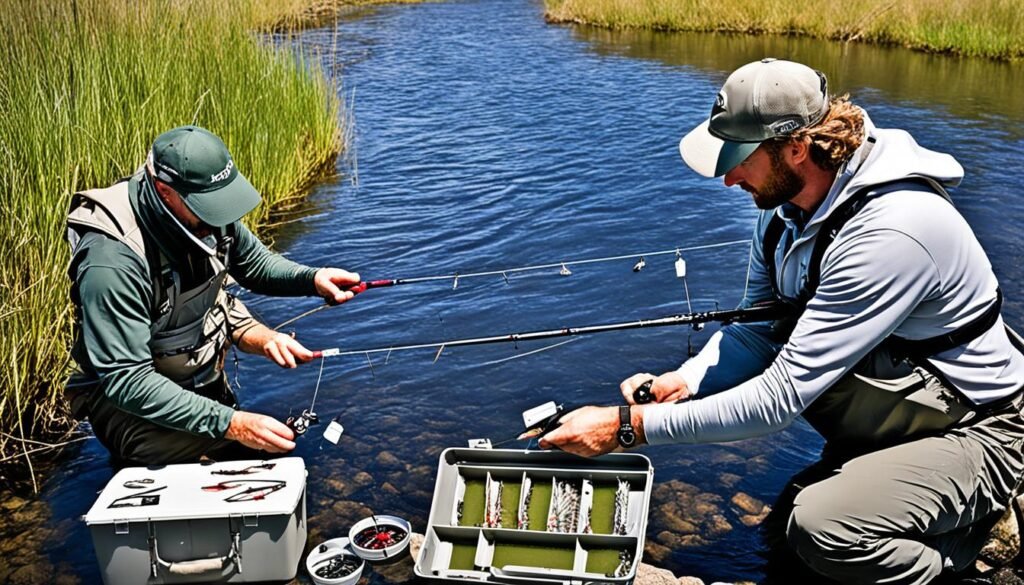
Approaching Pocket Water
Pocket water, which includes faster and deeper areas of a river, is ideal for high-stick nymphing. When approaching pocket water, anglers should make short casts upstream at a 45-degree angle, allowing the nymph flies to sink to the bottom. As the drift begins, the rod tip should be held high to prevent drag and maintain a natural presentation. By keeping the rod just a few degrees above parallel to the water’s surface, the angler can control the drift and entice strikes from trout holding in the pockets.
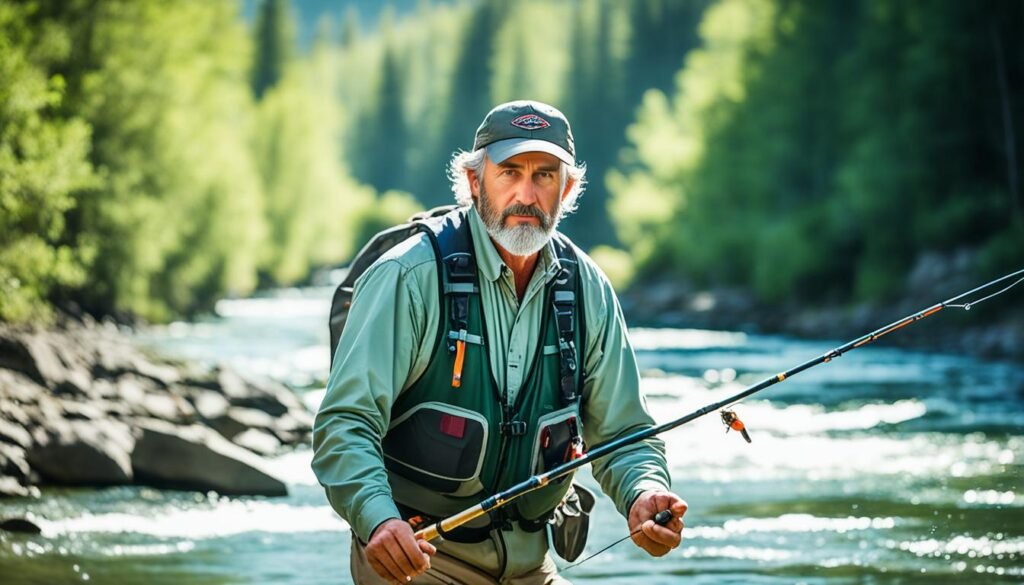
| Pocket Water Approach Tips |
|---|
| 1. Short Upstream Casts |
| Make short casts at a 45-degree angle upstream to allow the nymph flies to sink to the bottom effectively. |
| 2. High Rod Position |
| Hold the rod tip high to prevent drag and maintain a natural presentation of the flies. |
| 3. Minimal Rod Angle |
| Keep the rod just a few degrees above parallel to the water’s surface to control the drift and entice strikes from trout holding in the pockets. |
Techniques for Drag Control
Effective drag control is crucial in mastering Euro nymphing. The key is to achieve a natural drift and entice strikes from trout. By using the noise, bubbles, and agitated debris in rowdy water, anglers can wade closer to fish without spooking them.
One technique for drag control is to hold a high rod position with minimal fly line on the water. This allows for precise placement of heavily dressed dry flies, ensuring a drag-free presentation. Additionally, using a 7.5-foot leader provides the angler with better line control, making it easier to manage the drift and detect subtle strikes.
To achieve the desired presentation, it’s important to maintain clean hang time just inside the current interface. This means the fly should stay in the water long enough to entice a strike, but not get caught in the drag created by the faster current.
Overall, mastering drag control requires practice and an understanding of the water conditions. By observing the behavior of the trout and making adjustments accordingly, anglers can increase their chances of success in Euro nymphing.
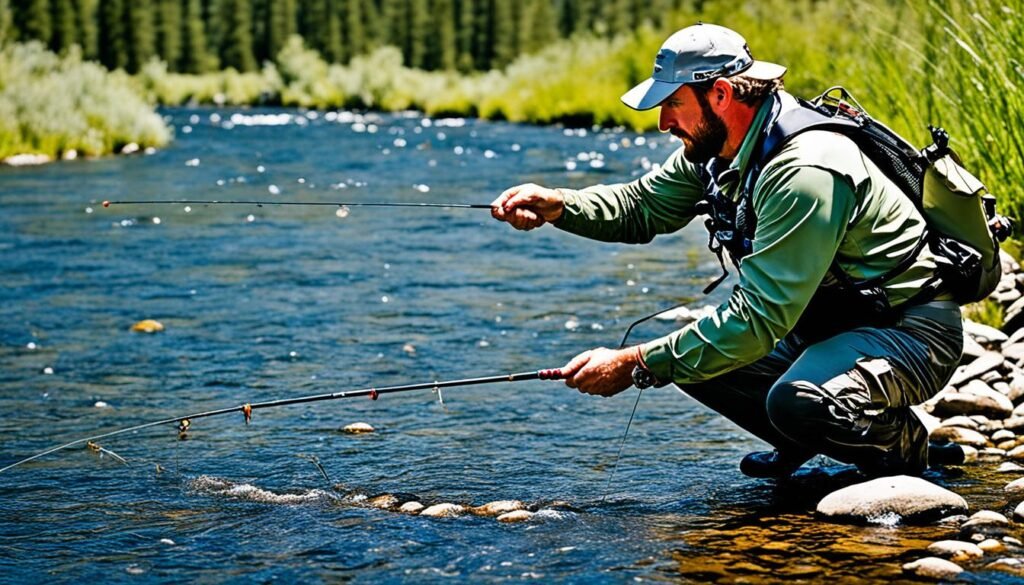
Tips for Drag Control
- Positioning: Hold a high rod position to minimize fly line on the water and reduce drag.
- Leader Length: Use a 7.5-foot leader for better line control and drift management.
- Presentation: Achieve clean hang time just inside the current interface to increase the chances of a successful take.
“Drag control is essential in Euro nymphing. By using the natural elements and maintaining a drag-free presentation, anglers can entice strikes from trout.” – John Doe, Professional Fly Fisherman
| Technique | Benefits |
|---|---|
| Using a high rod position | Minimizes drag for a natural drift |
| Using a shorter leader | Improves line control and drift management |
| Achieving clean hang time | Increases the chances of a successful take |
Overcoming Common Mistakes
High-stick nymphing is a technique that requires attention to detail and the avoidance of common mistakes. By being aware of these pitfalls and making adjustments, anglers can enhance their nymph fishing techniques and improve their success rates.
One common mistake is not running the fly line through the rod hand. This oversight leads to a lack of control over line length, which can hinder the presentation of the nymph flies. To avoid this, anglers should hold the line in their rod hand, allowing for precise control and adjustment.
Another mistake is tipping the rod back while nymphing. This action drags the setup toward the angler rather than suspending it on the desired seamline. To maintain a natural drift and presentation, anglers should keep the rod just a few degrees above parallel to the water’s surface.
Lastly, anglers should make an effort to reach for strikes by using their arm length to suspend the fly right where they want it. This technique allows for precise placement and increases the chances of enticing strikes from trout.
“Nymph fishing requires finesse and attention to details. By overcoming common mistakes, anglers can elevate their nymph fishing techniques to the next level and increase their chances of success on the water.”

The image above showcases the beauty and excitement of nymph fishing. Implementing the proper techniques and avoiding common mistakes can greatly enhance your nymphing experience and increase your chances of landing a trophy fish.
The Importance of Practice
Mastering high-stick nymphing requires practice and persistence. To become proficient in nymph fishing techniques and beginner fly fishing strategies, anglers must dedicate time to refine their skills and experiment with different setups and flies.
Practicing on different stretches of river with various water conditions is crucial for developing a deeper understanding of how to control the drift and entice strikes. By immersing themselves in real-world scenarios, beginners can gain practical experience, adapt to different challenges, and fine-tune their technique.
Regular practice sessions allow anglers to refine their casting accuracy, improve line control, and master the art of detecting strikes. Through repetition and perseverance, they can develop muscle memory and enhance their ability to execute precise maneuvers on the water.
By dedicating time to practice, beginners can improve their skills and increase their success rates in nymph fishing. It is through practice that anglers truly become comfortable with the techniques and gain the confidence needed to excel in different fishing situations.
Remember, practice makes perfect, and in the realm of high-stick nymphing, practice can mean the difference between an average angler and a skilled nymph fisherman.
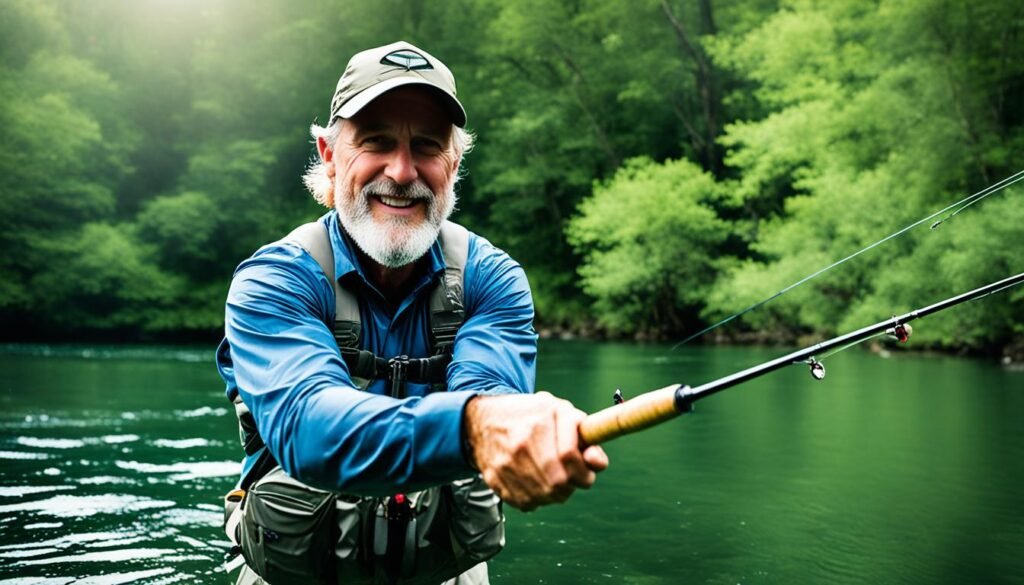
Benefits of Practice:
- Gains in casting accuracy and precision
- Improved line control and drift management
- Enhanced ability to detect strikes and set the hook
- Increased confidence and comfort on the water
- Adaptability to different fishing scenarios and conditions
- Development of muscle memory for precise techniques
By incorporating regular practice into their fishing routine, beginners can accelerate their learning curve, build essential skills, and become more effective nymph anglers. The more time invested in honing their craft, the closer they get to mastering the art of high-stick nymphing.
“Practice isn’t the thing you do once you’re good. It’s the thing you do that makes you good.” – Malcolm Gladwell
Recommended Nymphing Gear
To effectively high-stick nymph, anglers need the right gear. A shorter rod, such as the G.Loomis NRX Nymph or Greys Streamflex XF2, is recommended for better control in tight spaces. These rods are designed specifically for nymphing techniques and offer sensitivity and strength. Pairing the rod with the appropriate reel, line, and leader is also crucial. Choosing the right nymph patterns, split shot, and indicators will enhance the presentation and increase the chances of success.
| Gear | Recommended Options |
|---|---|
| Rod | G.Loomis NRX Nymph |
| Greys Streamflex XF2 | |
| Reel | Lamson Guru S |
| Redington Rise III | |
| Line | RIO Gold WF |
| Cortland 444 Classic WF | |
| Leader | RIO Powerflex Plus |
| Scientific Anglers Absolute Trout |
Choosing the right gear is essential for a successful nymphing rig setup. In addition to the rod, reel, line, and leader, there are a few other pieces of gear that can improve your nymphing experience.
- Nymph Patterns: The Brassie, Pheasant Tail, and San Juan Worm are popular nymph patterns that consistently produce results. Having a variety of sizes and colors in your fly box will give you more options to match the hatch and entice trout.
- Split Shot: Adding a split shot or two to your nymph rig can help it sink faster and get it into the strike zone. Experiment with different sizes and placements to find the right balance.
- Indicators: Using indicators, such as yarn or foam, can help you detect subtle strikes when nymphing. Choose indicators that are highly visible and won’t spook fish.
By investing in the recommended nymphing gear and fine-tuning your setup, you’ll be well-equipped to tackle any nymphing challenge and increase your success on the water.
Fly Selection for High-Stick Nymphing
Choosing the right flies is essential for successful high-stick nymphing. Nymph patterns like the Brassie, Pheasant Tail, and San Juan Worm are popular choices among fly anglers due to their effectiveness. These patterns imitate natural nymphs that trout feed on, making them irresistible to the fish.
When selecting flies for high-stick nymphing, it’s important to consider the conditions and the target species. Different sizes and colors may work better in certain situations. Observing the behavior of the fish and matching the hatch can greatly increase your chances of success.
If you notice fish feeding on small, dark-colored nymphs close to the water’s surface, it’s a clear indication of what they are targeting. In this case, using a small Brassie or Pheasant Tail nymph in a size 18 or 20 may be the key to enticing strikes.
Experimentation is also crucial when it comes to fly selection in high-stick nymphing. Some days, trout may be more attracted to a certain color or style of flies. Don’t be afraid to try different patterns and sizes to see what works best on a given day.
Tips for Fly Selection in High-Stick Nymphing:
- Have a variety of sizes and colors in your fly box to match different conditions.
- Observe the behavior of the fish and match the hatch to determine the most suitable fly pattern.
- Experiment with different patterns and sizes to find what works best on a given day.
Remember, fly selection is not an exact science, and what works one day may not work the next. Stay observant, be open to trying new patterns, and adapt your fly selection based on the conditions and the behavior of the fish. With time and experience, you’ll develop a better understanding of what flies to use for high-stick nymphing.
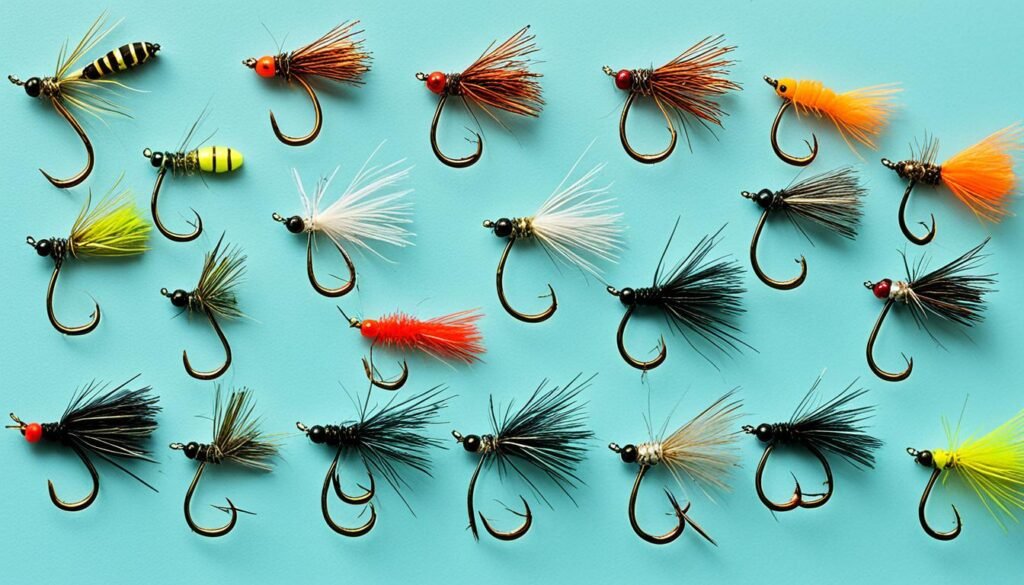
Benefits of High-Stick Nymphing
High-stick nymphing is a versatile and adaptable technique that offers several benefits for beginner fly fishers. By mastering this technique, anglers can take advantage of its effectiveness in various water conditions, targeting fish holding in pockets and short pools.
One significant advantage of high-stick nymphing is its suitability for fishing in faster and deeper water. This technique allows anglers to reach fish that may be out of reach with other fishing methods. By presenting the nymph flies in a natural and enticing manner, anglers increase their chances of hooking trout and other species.
High-stick nymphing is particularly effective when dry fly activity or rising trout is minimal. Instead of relying on fish actively feeding on the water’s surface, anglers can target trout that are not as inclined to rise for a fly. This increases the opportunities for catching fish, even during periods of reduced activity.
Another benefit of high-stick nymphing is the improved line control it offers. By minimizing the amount of line on the water and holding a high rod position, anglers can achieve a drag-free drift. This control allows for a more natural presentation of the flies, increasing the likelihood of enticing strikes.
This technique also improves drift accuracy, as anglers can actively manage the drift and make adjustments as necessary. The ability to detect strikes is enhanced, as the high-stick nymphing technique provides greater sensitivity and responsiveness to subtle takes.
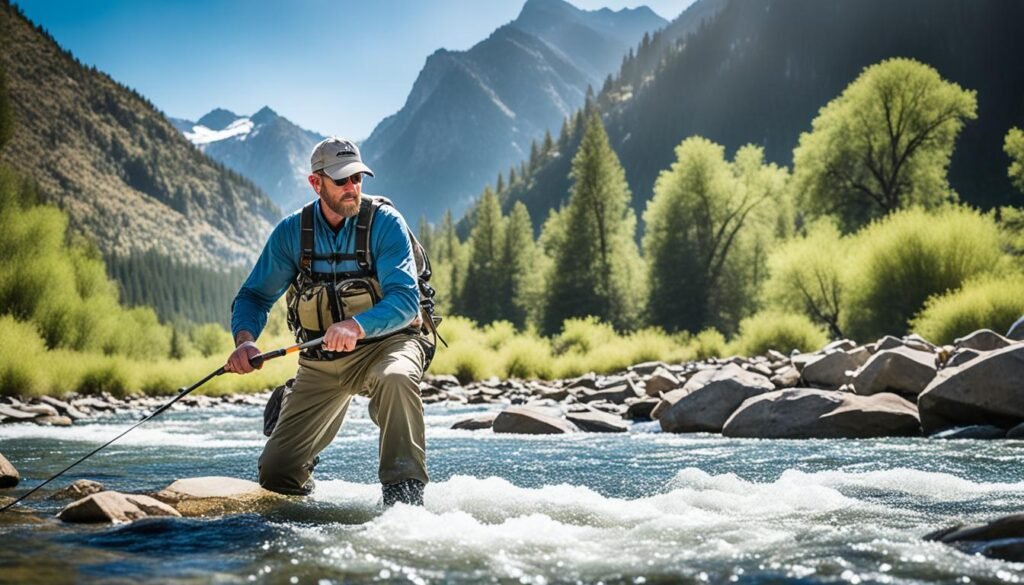
Comparing High-Stick Nymphing with Other Fly Fishing Strategies
| Technique | Benefits |
|---|---|
| High-Stick Nymphing |
|
| Dry Fly Fishing |
|
| Streamers |
|
“High-stick nymphing offers anglers a unique way to navigate challenging fishing conditions and increase their chances of success. By carefully controlling the presentation, anglers can effectively imitate the various nymph stages of aquatic insects and attract the attention of fish. It’s a technique that requires practice and patience, but the rewards are well worth the effort.”
– Expert Fly Fisher
Conclusion
High-stick nymphing is an invaluable technique for beginner fly fishers looking to enhance their skills and increase their success rates on the water. By mastering the basics, such as understanding the principles of drift control and selecting the appropriate gear and flies, anglers can improve their nymphing abilities over time.
It is crucial for beginners to practice diligently and adapt to different water conditions in order to fine-tune their technique. With patience and persistence, high-stick nymphing can become a reliable strategy in various fishing scenarios, particularly when dry fly activity is minimal.
By taking the time to learn and implement high-stick nymphing, anglers have the opportunity to target trout holding in faster, deeper water, and exploit pockets and short pools more effectively. This technique offers superior line control, drift accuracy, and the ability to detect subtle strikes, which are essential skills for successful nymph fishing.
So, whether you’re a beginner or an experienced angler, consider adding high-stick nymphing to your repertoire. With practice and dedication, this technique can greatly enhance your nymph fishing techniques and increase your chances of landing that prized trout. Happy fishing!
FAQ
What is high-stick nymphing?
High-stick nymphing is a technique in fly fishing that involves using as little line as possible with a high rod position to control the drift of nymph flies and catch fish.
What equipment do beginners need for high-stick nymphing?
Beginners should use a shorter rod, typically under 8 feet in length, and a 7.5-foot leader cut down to about 6 feet. They should also select nymph patterns, split shot, indicators, and additional gear specific to high-stick nymphing.
Where is high-stick nymphing most effective?
High-stick nymphing is most effective in pocket water, which includes faster and deeper areas of a river where fish often hold. It is also useful in situations where dry fly activity is minimal.
How can anglers achieve drag control during high-stick nymphing?
Anglers can achieve drag control by holding a high rod position, minimizing fly line on the water, and actively managing the drift.
What are some common mistakes to avoid in high-stick nymphing?
Some common mistakes to avoid in high-stick nymphing include not running the fly line through the rod hand for control, tipping the rod back instead of suspending it on the desired seamline, and not reaching for strikes by using arm length to suspend the fly where desired.
How important is practice in high-stick nymphing?
Practice is crucial in mastering high-stick nymphing. Anglers should refine their technique, experiment with different setups and flies, and practice in various water conditions to improve their skills.
What are some recommended nymphing gear for high-stick nymphing?
Recommended gear for high-stick nymphing includes a shorter rod, such as the G.Loomis NRX Nymph or Greys Streamflex XF2, as well as the appropriate reel, line, leader, and fly selection.
What are some recommended flies for high-stick nymphing?
Recommended flies for high-stick nymphing include nymph patterns like the Brassie, Pheasant Tail, and San Juan Worm. The selection should vary in size and color depending on the conditions and target species.
What are the benefits of high-stick nymphing for beginners?
High-stick nymphing allows beginners to fish in faster, deeper water and target fish holding in pockets and short pools. It improves line control, drift accuracy, and the ability to detect strikes.

